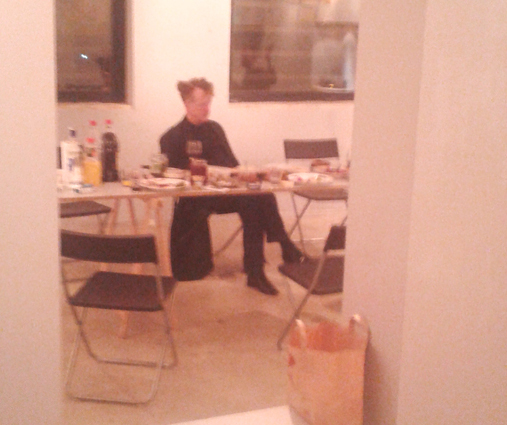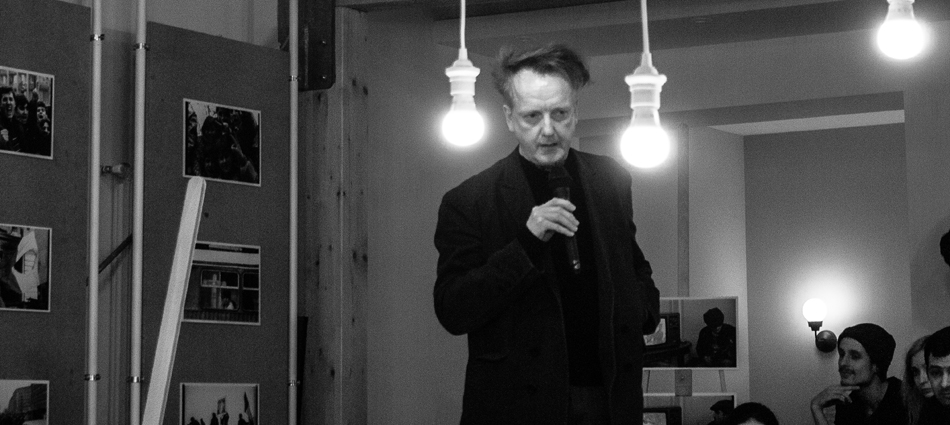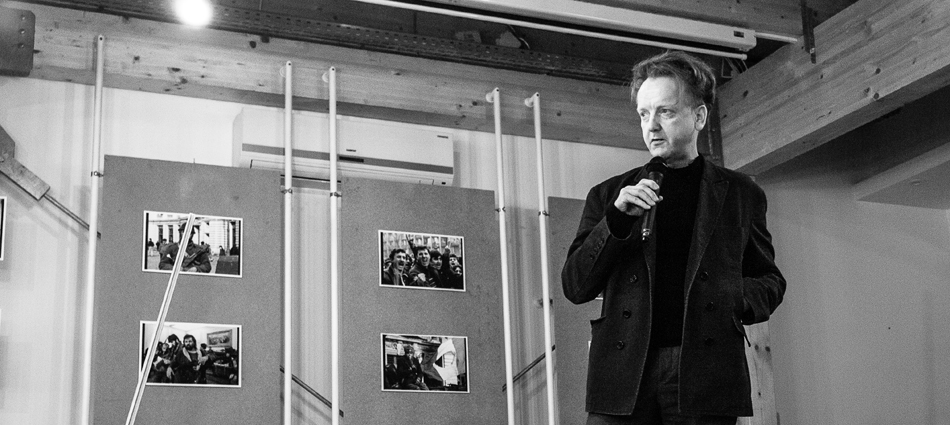Jonathan Lahey Dronsfield, a British philosophy professor of Irish descent and self-ascribed artist-philosopher was invited to Bucharest between mid-December 2014 – mid-January 2015 as artist in residence at ODD, a new cultural space which was inaugurated in Bucharest on this occasion. Jonathan Lahey Dronsfield currently has work showing in Dispositions in Time and Space at the New Museum of Contemporary Art (MNAC) Bucharest, four sections of his book in progress The Swerve of Freedom after Spinoza. He was selected for the first Mobile Biennale last summer in Oltenia, Romania. The Spinoza project has involved giving a 24-hour reading of The Ethics (also in the summer, at N Raum Gallery Berlin), and then a reading over 24 hours of the transcription of that reading and discussion (last month at KaaiTheaterStudios Brussels), to be followed by a reading over 24 hours of that reading and discussion (forthcoming in Vienna), and so on. Dronsfield has given performative readings of his work at many galleries, including Wilkinson Gallery London, Focal Point Gallery Southend-on-Sea, Extra City Kunsthal Antwerp, Stroom Den Haag, S.M.A.K. Ghent, Pallas Contemporary Projects Dublin, Sketch Gallery London, and at various other locations, including Cabaret Voltaire Zürich, L’institut francais London, and IKEA Ashton-under-Lyme; has had work included in a number of exhibitions, including la Biennale di Venezia 54 and art:gwanju 12; and has worked collaboratively with artists Ian Kiaer, Gregory Maass & Nayoungim, Benoït Maire, and Haroon Mirza.
For his project as an artist in residence at ODD, Jonathan Lahey Dronsfield was constantily available for two weeks at the galery space in order to show publicly footage made on the occasion of his first trips in Romania in 1988 and 1989, while he was a young film and philosophy student, some of which he then showed in the European Parliament at that time. He has also screened for an audience a number of films at the intersection of art and politics, followed by talks on some of the most important problems facing Europe today: freedom and democracy, capitalism and being-in-common, activism and enthusiasm. I asked Jonathan Lahey Dronsfield a few questions regarding his artistic endeviour and his interest in Romania.
What is an artist-philosopher, Jonathan? Is he or she both of those things, or perhaps neither, but a different sort of creature altogether?
Both and neither. My idea of an artist-philosopher takes as one of its points of departure Nietzsche’s self-conception in the last years of his life. So on the one hand an artist-philosopher would be a philosopher for whom his life is his work, and whose work is an experiment in living. But on the other it would be an artist whose work is not just ‘philosophically informed’, indeed not even importantly that, but which puts philosophy into practice and inquires philosophically through practice, where the practice might reveal a sense of the philosophy that the philosophy ‘by itself’ is blind to. The artist-philosopher is an old story, but it’s a ‘new species’ one sees more and more in the art world, artists with selective knowledge drives working not for the store of knowledge but putting it into service for living well and leading better lives. Perfecting oneself as a form where the form is an ongoing process, not as if perfection is achievable – that would be unhealthy – but forever ‘to come’. The constitutive role creative transformation, or rather self-creative transformation, plays in comprehension. But this is not the romantic conception of the philosopher or artist subject, not the legislator poet-artist of 19th century romanticism, not the activist art ‘praxis’ of late 1960s Western Europe, not a ‘political’ art which seeks to negate itself as art in an aesthetics of disappearance into the social, whatever that is. It is work which puts into question notions such as the subject, the legislator, activism, negation, aesthetics – and which does not acknowledge any hierarchy between art and philosophy in doing so. If it is art, if it is, then it is art which rejects an order of dependency which would see philosophy legislate the priority of a theoretical and abstract conception of concepts over their practical derivation. If it is philosophy, if it is, then it is philosophy which does not grant art sovereignty over the sensuous.
Let’s talk a little about your current project at ODD. Your residency included almost daily screenings of film, such as Jean-Luc Godard’s Film Socialisme, Alexander Kluge’s 9½ hour-long News from Ideological Antiquity and Andrei Ujică’s Autobiography of Nicolae Ceauşescu. Why did you choose communism as a theme for this series of screenings? Did we not have enough of it already?
Yes we have without doubt had enough of communism. And this is why I wanted to ‘read’ it again. I wanted to read communism without the ‘ism’, or in its plurality, in other words displaced from its politicisedal and ideologisedcal articulations. Discussion about communism, especially in France since the delusions of Mai ’68 have been seen for what they were, has led to the sorts of ideas which I would wish to explore. I’m thinking of the writings of Maurice Blanchot (‘On an approach to communism’, ‘Marx’s three voices’), Jean-Christophe Bailly (La Comparution), Jean-Luc Nancy (various writings on being-in-common), Jacques Rancière (on equality, on democracy), and Jacques Derrida (Spectres of Marx): community without leader, politics without the party, the state without nationhood, unions of states without internal borders, gathering without togetherness, association without the collective, being-in-common without identity, the conjoining and disjoining of the disparate without dissolution, the possibilities of ‘welcoming’ and hospitality and dissidence and refuge and foreignness with all these ‘without’s, difference with equality, dispersion with rights, mobility with freedom – and the relation of all these to the promise of democracy, the risk and chance of democracy and the indetermination at its heart. And perhaps above all the prospects and opportunities for exploring these problematics in art, the potential of art as the one ‘in common’ where all such questions can be given time and space to seen and heard.
So I decided to read communism through film – I am making a film – films at the intersection of art and politics, and films comprised of different sorts of material, whether that be newsreel or archive footage (as in Ujică’s film or Ben Lewis’ The King of Communism), monuments of fallen communist leaders (Laura Mulvey’s Disgraced Monuments), fiction as philosophy/philosophy as fiction (Godard) or, as in the case of Kluge’s News from Ideological Antiquity, a film drawing together many different forms of material, including film itself. Kluge’s film is a film of Sergei Eisenstein’s Notes on a project to film Marx’s Das Kapital. Kluge’s film asks What is it to make a film on a film unmade? And you cannot ask that question of Eisenstein’s Notes, says Kluge, without unfolding another one, namely If capital could speak, what would it say? And to unfold that question you must raise it from the perspective of those to whom capital speaks.
Your project is entitled The Fall of Enthusiasm and in the ‘open letter’ which you address to Romanians you mention “the pathology of enthusiasm”. What does that refer to? Do you equate enthusiasm with socialism or maybe with revolutions and dreams of building a new society in common? Do you think enthusiasm at the societal scale is still possible and would that be a good thing considering where it has often led in history?
Actually I address the letter to Romanians “and other enthusiasts of democracy”. The last time I was in Romania was in November, to install work at MNAC in a show entitled Dispositions in Time and Space. Iohannis had just been elected President. There was a newspaper one could find everywhere, and its headline was ‘Entuziasm!’ Enthusiasm does seem to be intimately linked to the politics of socialism. Which perhaps is one reason why my project has been about enthusiasm from the start – at which moment I was more convinced of the virtues of a new society ‘in common’ than I am now, and than I was after I returned from my very first trip to Romania in 1988. Very early on, back in 1990 I think, I obtained the right from Mosfilm to use some of Dziga Vertov’s 1931 film Entuziazm – which we also screened in the gallery space. I wanted it for its rhythm. The sub-title of that film is The Donbas Symphony. The Donbas is precisely the area being fought over in Ukraine as we speak. One might say that it is the last frontier of Europe, the final chapter of the encounter between the former West and its East which began with the fall of the Berlin Wall and the 1989 ‘revolutions’ of Central and Eastern Europe. But of course, we cannot say ‘final’, who knows what will happen. But what we can say is that what is taking place in Ukraine is one way in which the Romanian revolution, the last and most bloody of the 1989 revolutions, has yet to end, because it is being played out along the same fault line, and is a response to the same promise – or threat depending on which way you look at it – the promise of the idea of Europe, to which it could be said that a majority of Ukrainians have responded enthusiastically, but which the European Union will take a long time redeeming not least because of the way the ruling elite in Russia have resisted it on behalf of Ukraine.
The ‘pathology’ of enthusiasm refers to the affective nature of the concept as it is figured in Kant. On the level of ethics, enthusiasm is unhealthy. It’s like an infection. Ethics, for Kant, must be free from any determining pathos. But on the level of aesthetics enthusiasm is a powerful driving force for the imagination, it is sublime. It’s the tension between these that interests me, and how one might regulate their economy and the passage of one to the other. Spinoza sees enthusiasm to be the cause of religious zealotry, of servility to Scripture over belief in it. Your own Cioran says of enthusiasm that it is “a morbid state responsible for almost all public and private disasters”, and that the worst crimes are committed in its name [De l’inconvénient d’être né]. An altogether more positive conception of enthusiasm is held by a major thinker of communism and its contemporary possibilities, Alain Badiou. If Badiou had his way then there would certainly be more public disasters. For Badiou, enthusiasm is the very intensity of politics. Politics is one of his four truth procedures, which each happen to have a single affect. Enthusiasm is the affect through which one experiences the truth of politics. Politics is the collective plus enthusiasm. Were Badiou’s theory to be put into practice, the collective plus enthusiasm would equal disaster. It is enthusiasm which infects Badiou’s descriptions of the empirical reality his politics wishes to change. So to that extent one answer to your question is ‘No’, enthusiasm would not be a good thing.
You have brought with you some 70 hours’ worth of film footage, some of it shot clandestinely in Romania in 1988 and ’89, and also some which you have not seen since you first made it. What do you plan to do with it?
I have footage from various visits over a period of more than 25 years, including as you say film shot clandestinely, and footage shot whilst being followed by the Securitate or trying to get away from them. That footage is precarious and at times filmed without being aware of what it was we were filming – in the sense that we came here not knowing what we might see nor whether we would be able to film. In the event nothing could have prepared me for what a communist ‘society’ is. And I could not fathom a certain passivity on the part of the people. I also have footage from the revolution – an event that was not prefigured or even hinted at in the journeys over the preceding 18 months or so. The final footage was gained in the summer on the Mobile Biennale in Oltenia, and during my time at ODD. The footage exists in a number of formats, including super-8 and 16mm film, and various mainly defunct gauges of video, and some of it I have not viewed since shooting it, and some I did not know I had shot or had no recollection of having shot. The time has come to gather the footage together and inspect it for its possibilities for shaping and giving form to my ideas on change, freedom, enthusiasm, nationalism, the idea of Europe, the promise of democracy, whilst at the same time reflecting on the impossibility of making a film across such a long period of time, something which will take the form of a fictionalised exchange between two characters whose relationship has failed. I’m being assisted in this by two works, one I have already mentioned, Kluge’s News from Ideological Antiquity, a film about a film unmade; the other is Jacques Roubaud’s The Great Fire of London, a book about a book unwritten. I wanted to inspect the footage in public, hence my spending two weeks at ODD viewing it in a gallery space open to the public. The hope was to look at the artist as a witness from the point of view of the witness, to displace oneself as witness by viewing the work through the eyes of another as it were. The debates and arguments that were had along the way certainly helped in this regard. The next stage is to edit the footage, also in public.
Jonathan, thank you for your time.
The Fall of Enthusiasm was at ODD between 24 December 2014 – 8 January 2015.
POSTED BY
Ștefan Iancu
A philosophy graduate from the University of Bucharest, who then went on an MA program in Gender Studies at University of Saskatchewan in Canada. Currently a PhD candidate in Political Science at the ...



Comments are closed here.